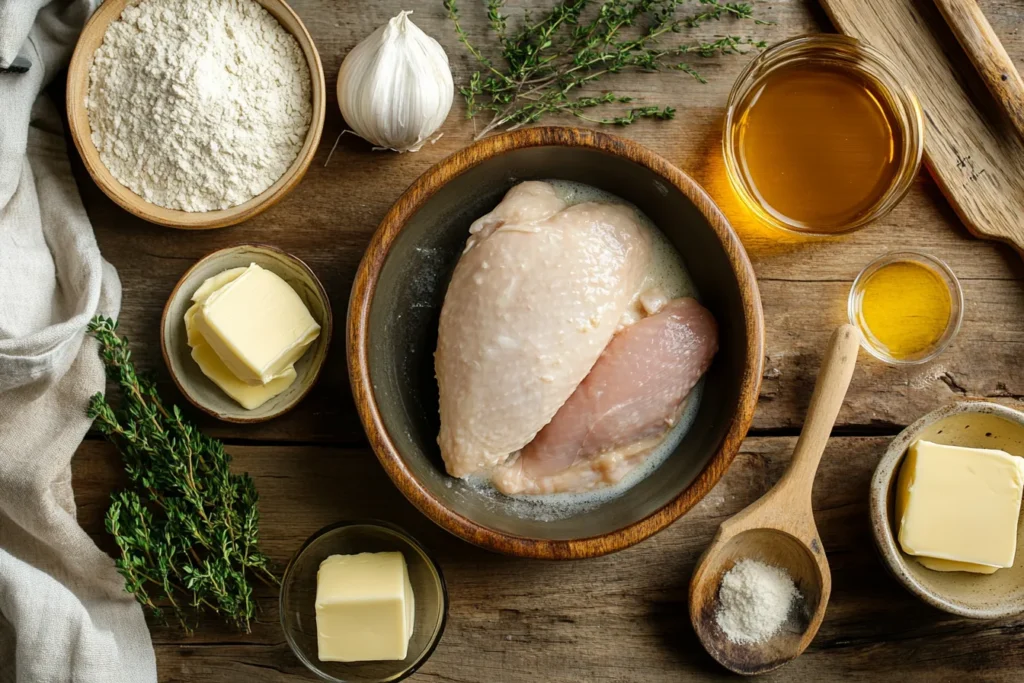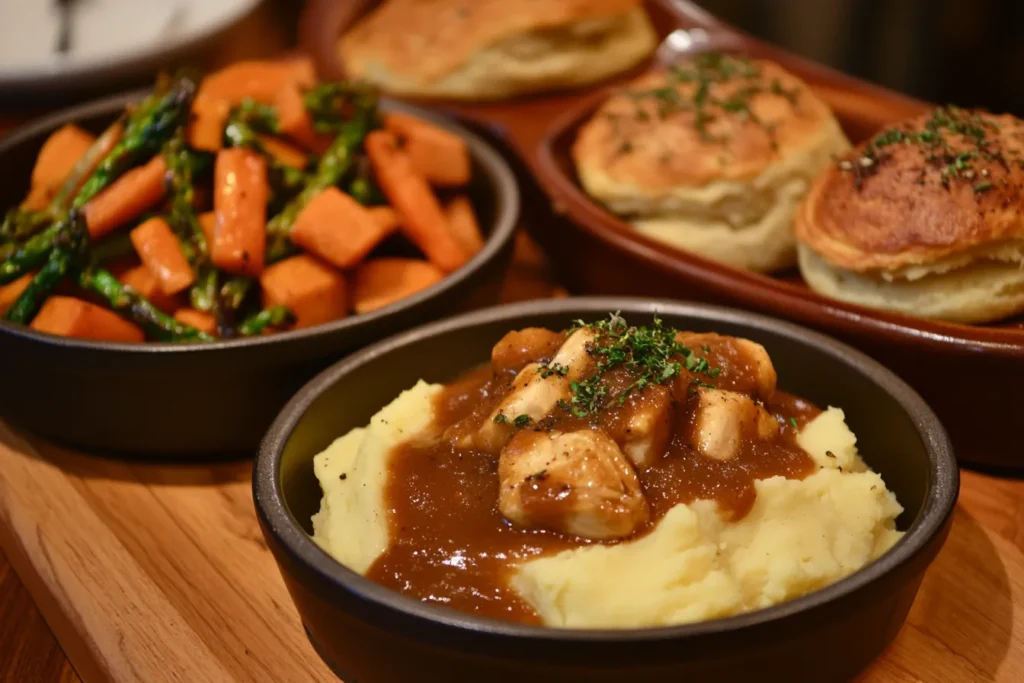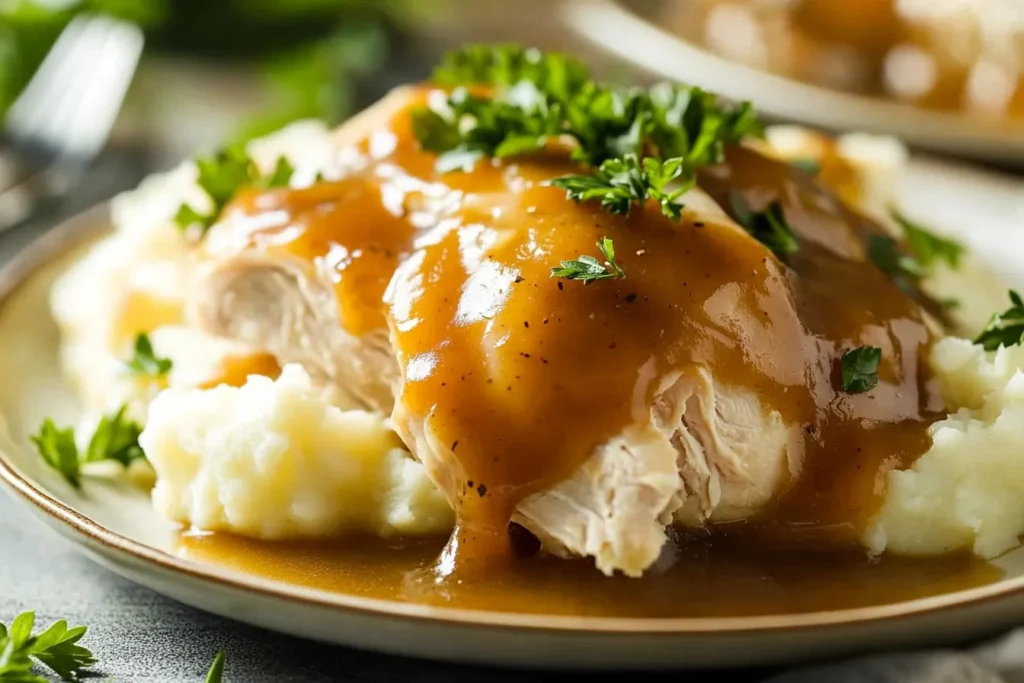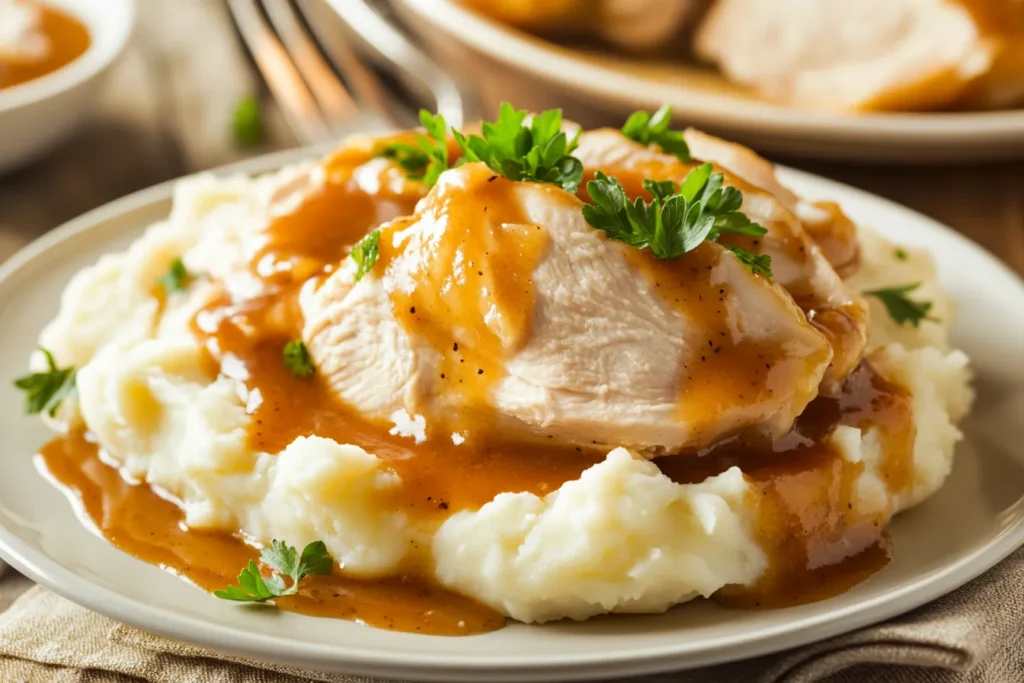Table of Contents
How to make a good chicken gravy is a culinary skill worth mastering. A rich, flavorful gravy can transform a simple roast chicken into a memorable meal. The process isn’t difficult. However, a few key techniques ensure success every time. This guide provides the ultimate secrets for achieving perfect chicken gravy.
The Essential Foundation: Broth and Fat
The foundation of any great gravy lies in the quality of the broth and fat. Starting with homemade chicken broth greatly enhances flavor. Alternatively, a good quality store-bought broth works fine. The fat can come from roasting the chicken itself or from butter. Combining both is often ideal.
Preparing the Pan Drippings
After roasting your chicken, let it rest. Then, carefully pour off the pan drippings. Use a gravy separator to remove excess fat. However, don’t discard all of it. You need some fat to create a roux. This ensures a smooth, lump-free gravy (How to make a good chicken gravy).
The Importance of a Good Roux
The roux is the thickening agent for your gravy. It’s made by cooking equal parts fat and flour together. Cook it over medium heat, stirring constantly. You want a light golden color, not burned. This is crucial for both flavor and thickening power.

Building Layers of Flavor
Flavorful gravy doesn’t rely on just the basics. Additional ingredients enhance its complexity. Simple additions make a big difference. Consider herbs, spices, and aromatics.
Incorporating Aromatics
Aromatics like onions and garlic are beneficial. Sauté them in the pan before adding flour. This adds depth to the gravy’s base. Some people enjoy celery as well. These build the essential flavor profile (How to make a good chicken gravy).
Choosing the Right Herbs and Spices
Fresh herbs are ideal for the best flavor. Thyme and rosemary are classic choices for chicken. However, consider dried herbs as well. A pinch of salt and pepper is essential, of course. A touch of nutmeg can add surprising warmth.
Deglazing the Pan for Maximum Flavor
Deglazing is a critical step for flavor extraction. After removing the aromatics, pour in a splash of white wine or broth. Use a spatula to scrape up any browned bits from the pan. These bits are known as “fond.” They are full of concentrated flavor. This adds layers of complexity.
The Art of Perfect Consistency
A good gravy is neither too thick nor too thin. It should coat the back of a spoon nicely. This is not just about achieving thickness, but also the right consistency. You should never have lumpy gravy.
Gradual Addition of Broth
Add the broth gradually to the roux. Whisk constantly to prevent lumps from forming. Start with a small amount. Then slowly increase the quantity. This allows the gravy to thicken evenly.
Adjusting Thickness and Seasoning
Simmer the gravy until it reaches the desired consistency. If it’s too thick, add more broth. If too thin, continue simmering. Remember to season to taste. This may take a few tries but it is essential (How to make a good chicken gravy).

Straining for Ultimate Smoothness
For an ultra-smooth gravy, strain it through a fine-mesh sieve. This removes any remaining bits of onion or herbs. Some people prefer a rustic gravy. Therefore, they may skip this step. However, for restaurant style gravy, it can make a big difference (How to make a good chicken gravy).
Alternative Approaches to Chicken Gravy
There are various ways to approach chicken gravy. These alternatives may suit your specific tastes. Some of these are simpler for busy weeknight cooking. Others will offer a unique experience for a special occasion.
Using Chicken Gravy Mix
Chicken gravy mix is a quick option. However, homemade gravy tastes much better. If using mix, enhance it with extra flavors. Add a bit of butter, some herbs, or some drippings.
Creamy Chicken Gravy
For a richer gravy, add cream or milk. Incorporate it at the end of the cooking process. This is ideal for those who prefer a creamy style. Adding a dollop of sour cream is an alternative approach.
Gluten-Free Options
For those avoiding gluten, use gluten-free flour to make the roux. Alternatively, use cornstarch as a thickener. Make sure you add the cornstarch to a cold liquid. Otherwise, the gravy will lump.

How to Make a Good Chicken Gravy: Key Takeaways
Mastering how to make a good chicken gravy involves a few key principles. Use good quality ingredients, including fresh herbs. Pay close attention to the roux. Remember to deglaze the pan. Gradually add the broth to avoid lumps. Season to taste and adjust the consistency.
Don’t Rush the Process
Patience is an important virtue in cooking. Do not rush any of the steps. It is especially important to cook the roux properly. Also, take care while deglazing the pan. This will make the difference between good and great gravy (How to make a good chicken gravy).
Practice Makes Perfect
Making gravy may feel intimidating at first. However, with practice you’ll improve. Do not be afraid to experiment with various flavors. Once you get the basics right, you can easily modify it for your own tastes (How to make a good chicken gravy).
How to Make a Good Chicken Gravy?
How to make a good chicken gravy involves several simple yet essential steps. You must make sure to start with good fat and broth. Don’t skip creating a proper roux. Building layers of flavor using aromatics and herbs elevates the final result. Finally, adjusting the consistency and seasoning ensures the gravy is perfect for your tastes. Making gravy is a rewarding experience. The result is a rich, flavorful sauce that complements almost any meal.
Troubleshooting Common Gravy Problems
Even with careful preparation, you might encounter issues. Here’s how to tackle common gravy problems. Addressing issues quickly can save the whole sauce. It is better to fix them right away than just throwing it out (How to make a good chicken gravy).
Lumpy Gravy Solutions
Lumps in gravy are frustrating. Prevent them by whisking constantly while adding broth. If lumps do form, use a hand blender to smooth it out. Straining the gravy also works wonders.
Gravy That’s Too Thin
Thin gravy may result from adding too much liquid. Simmer the gravy to reduce it. You can also thicken it with a cornstarch slurry. Just remember to add it slowly.
Gravy That’s Too Thick
Gravy can become too thick if it reduces too much. Gradually add more broth or stock to thin it out. A bit of hot water may also help. Whisk it in until the desired consistency is reached.
Serving Suggestions and Meal Pairings
Chicken gravy is versatile. You can pair it with numerous dishes. Here are some ideas for serving and meal pairings. From holiday meals to quick weeknight dinners. The possibilities are endless.
Classic Comfort Foods
Chicken gravy pairs perfectly with mashed potatoes. It complements roasted chicken and stuffing. Consider adding it to biscuits for a savory treat. These are great for holiday gatherings and potlucks (How to make a good chicken gravy).
Creative Meal Combinations
Use chicken gravy as a base for pot pies. It goes well with shepherd’s pie or chicken fried steak. Think about pouring it over open-faced hot chicken sandwiches. It’s also great with rice or polenta.
Adding Veggies and Sides
Roasted or steamed vegetables are a good match for the richness of gravy. Try green beans, carrots, or peas. A side of cornbread or biscuits completes the meal. A simple salad lightens up a heavy meal.
Storing and Reheating Leftover Gravy
You’ll likely have leftover gravy. Proper storage and reheating ensure its quality. This also makes cooking ahead easier. These tips will maintain the best possible flavor and texture.
Refrigerating Leftover Gravy
Let leftover gravy cool completely before storing it. Transfer it to an airtight container. Refrigerate promptly for up to three days. This will maintain its freshness and prevent spoilage.
Freezing Gravy for Later
For longer storage, freeze your gravy. Portion it into freezer-safe containers. Freeze for up to three months. Thaw it in the refrigerator overnight before reheating. Always reheat thoroughly to a safe temperature.
Reheating Techniques
Reheat gravy on the stovetop over low heat. You can also reheat it in the microwave. Add a splash of broth if needed to thin it. Stir frequently to ensure even heating. Watch closely to prevent burning.
FAQ
chicken and gravy recipe
A basic chicken and gravy recipe involves roasting a chicken, reserving the drippings, creating a roux with fat and flour, adding broth and aromatics, and simmering until thickened. The ratios of flour to fat and liquid will depend on how much gravy you need and how thick you prefer it. Remember to always add liquids gradually while constantly whisking the roux.
What goes well with chicken and gravy?
Chicken and gravy pair exceptionally well with mashed potatoes, roasted vegetables (like carrots and parsnips), rice, biscuits, and egg noodles. Consider serving it with a side of green beans, corn, or peas for a balanced meal. A simple green salad can offer a fresh counterpoint to the rich gravy. Remember that gravy can also be poured on top of other protein dishes.
How can I make chicken gravy taste better?
To make your chicken gravy taste better, focus on using homemade broth, deglazing the pan with wine or broth to capture the fond, adding fresh herbs, and seasoning generously. Additionally, you can enhance the richness by adding a bit of butter or cream at the end. Using good quality ingredients from the start also makes a huge difference. Don’t skip the key steps.
What is in chicken gravy mix?
Chicken gravy mix typically contains wheat flour, modified corn starch, salt, hydrolyzed vegetable protein, chicken fat, onion powder, spices, and flavorings. These ingredients create a thickened sauce base. However, the flavor is not as fresh as homemade gravy. It’s a quicker alternative, but homemade provides better taste control and quality.

